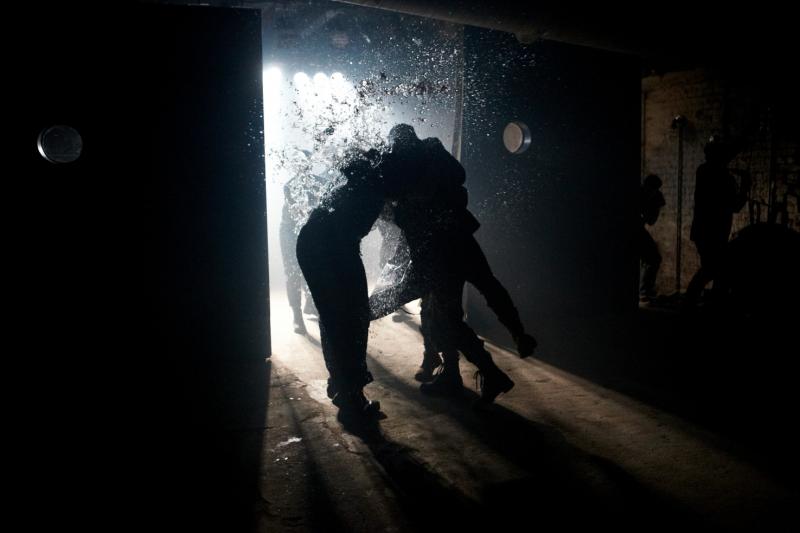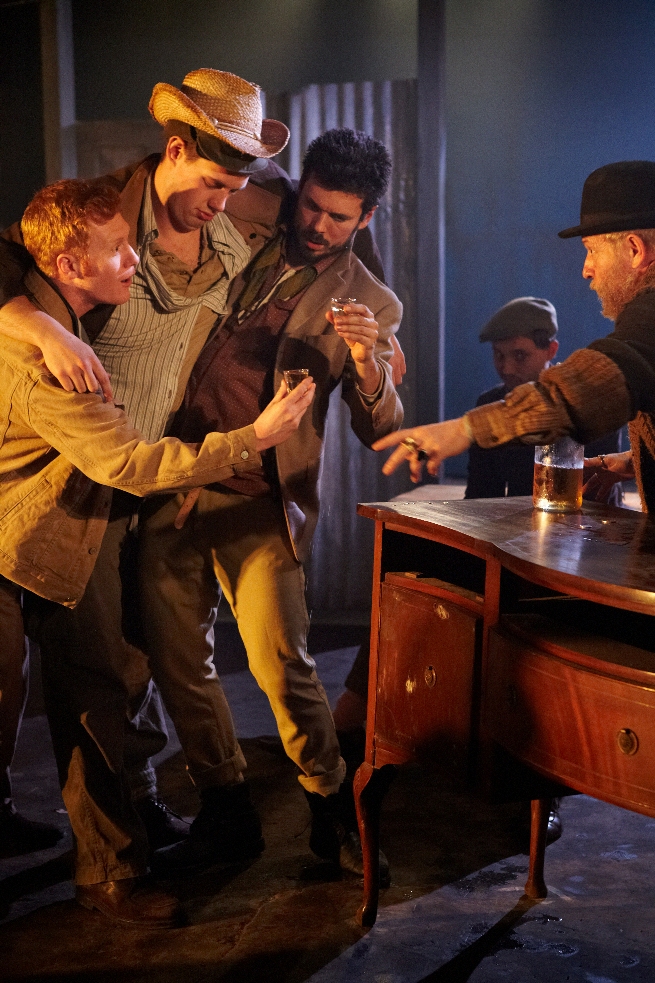The Sea Plays, Old Vic Tunnels | reviews, news & interviews
The Sea Plays, Old Vic Tunnels
The Sea Plays, Old Vic Tunnels
O'Neill's seafaring trilogy is given the immersive treatment

The Old Vic Tunnels would seem to be the perfect place to set three of Eugene O’Neill’s three earliest plays about the sea, drenched as they are in the stench of life in the heavy engine room of merchant navy life. For the tunnels, secreted directly underneath Waterloo Station, shudder ceaselessly to the rumble of trains overhead and are saturated in their own heavy industrial atmosphere. Indeed as you enter you’re hit by the smell of dust and damp running at full blast. Come prepared.
Waterloo Station’s converted railway vaults, barely two years old, however, have been steadily turned into an avant gardist’s dream palace with Banksy, New York Dolls and the Boom Boom Cabaret Club all appearing as recent headliners. It’s no place, however, for the faint of heart. Nor, if we’re to believe O’Neill who roamed the high seas before turning his experiences into such piercing stage plays as Anna Christie and The Iceman Cometh, was merchant sailing anything other than something close to hell on earth in the early part of the century. These three plays, Bound East for Cardiff, In the Zone and The Long Voyage Home, expose a sailor’s life as one of unrelenting hardship endured only through an intense sense of camaraderie.
This is a vivid, violently realistic and heavily male production
Known as The Sea Plays, this trilogy of one-acters are among O’Neill’s earliest and least performed works. The first, Bound East for Cardiff indeed was the one that in July, 1916 launched the playwright when it was performed in a rickety converted fish house in Provincetown on Cape Cod; the Provincetown Players theatre group set sail with O’Neill as one of its leading lights.
Kenneth Hoyt, himself a director of today’s Provincetown Theatre, should presumably know his O’Neill backwards. If so, he’s made some strange choices. Misjudging the vault’s immersive qualities, he’s clearly taken hyper-realism as his cue with less than positive results. O’Neill’s great gift is his talent for characterisation. In a few short strokes, he can create characters who come pulsatingly alive. Leave the plays to do the talking and you won’t fail.
 Hoyt initially however fills the vaults with thundering clatter. The opening minutes are a tokenistic embarrassment with bare-chested men of toil supposedly stoking coal, swathed in sweat. We are invited to gaze at them as if at some zoological specimen. A storm at sea is then represented with sound and fury, swinging lights, straining ropes and heavy metal doors gallantly yanked back and forth by the hard-working acting crew, all unnecessarily laborious beside the brilliant storm evoked by Rob Ashford for the Donmar’s Anna Christie revival last year with merely a rope and lights.
Hoyt initially however fills the vaults with thundering clatter. The opening minutes are a tokenistic embarrassment with bare-chested men of toil supposedly stoking coal, swathed in sweat. We are invited to gaze at them as if at some zoological specimen. A storm at sea is then represented with sound and fury, swinging lights, straining ropes and heavy metal doors gallantly yanked back and forth by the hard-working acting crew, all unnecessarily laborious beside the brilliant storm evoked by Rob Ashford for the Donmar’s Anna Christie revival last year with merely a rope and lights.
Only when the noise stops and the play is allowed to start speaking for itself – a tale of yearning to be settled, of guilty conscience as death beckons and also one of rich seafaring memories – does the evening start to take hold.
And happily, the cumulative surge continues, building to a tremendous climax, partly because the same characters and crew from the fictional tramp steamer, the SS Glencairn, turn up in each play and partly because the final moments of The Long Voyage Home epitomise so tragically one of O’Neill’s major themes, the trapped nature of these young men’s lives (and overwhelmingly it is a man’s world). Another of The Long Voyage Home’s themes too, of a longing to go home, to settle down, carries a wonderful circularity, bringing us back to the beginning and the first play. This is a vivid, violently realistic and heavily male production.
- The Sea Plays at the Old Vic Tunnels until 18 February
The future of Arts Journalism
You can stop theartsdesk.com closing!
We urgently need financing to survive. Our fundraising drive has thus far raised £49,000 but we need to reach £100,000 or we will be forced to close. Please contribute here: https://gofund.me/c3f6033d
And if you can forward this information to anyone who might assist, we’d be grateful.

Subscribe to theartsdesk.com
Thank you for continuing to read our work on theartsdesk.com. For unlimited access to every article in its entirety, including our archive of more than 15,000 pieces, we're asking for £5 per month or £40 per year. We feel it's a very good deal, and hope you do too.
To take a subscription now simply click here.
And if you're looking for that extra gift for a friend or family member, why not treat them to a theartsdesk.com gift subscription?
more Theatre
 The Maids, Donmar Warehouse review - vibrant cast lost in a spectacular-looking fever dream
Kip Williams revises Genet, with little gained in the update except eye-popping visuals
The Maids, Donmar Warehouse review - vibrant cast lost in a spectacular-looking fever dream
Kip Williams revises Genet, with little gained in the update except eye-popping visuals
 Ragdoll, Jermyn Street Theatre review - compelling and emotionally truthful
Katherine Moar returns with a Patty Hearst-inspired follow up to her debut hit 'Farm Hall'
Ragdoll, Jermyn Street Theatre review - compelling and emotionally truthful
Katherine Moar returns with a Patty Hearst-inspired follow up to her debut hit 'Farm Hall'
 Troilus and Cressida, Globe Theatre review - a 'problem play' with added problems
Raucous and carnivalesque, but also ugly and incomprehensible
Troilus and Cressida, Globe Theatre review - a 'problem play' with added problems
Raucous and carnivalesque, but also ugly and incomprehensible
 Clarkston, Trafalgar Theatre review - two lads on a road to nowhere
Netflix star, Joe Locke, is the selling point of a production that needs one
Clarkston, Trafalgar Theatre review - two lads on a road to nowhere
Netflix star, Joe Locke, is the selling point of a production that needs one
 Ghost Stories, Peacock Theatre review - spirited staging but short on scares
Impressive spectacle saves an ageing show in an unsuitable venue
Ghost Stories, Peacock Theatre review - spirited staging but short on scares
Impressive spectacle saves an ageing show in an unsuitable venue
 Hamlet, National Theatre review - turning tragedy to comedy is no joke
Hiran Abeyeskera’s childlike prince falls flat in a mixed production
Hamlet, National Theatre review - turning tragedy to comedy is no joke
Hiran Abeyeskera’s childlike prince falls flat in a mixed production
 Rohtko, Barbican review - postmodern meditation on fake and authentic art is less than the sum of its parts
Łukasz Twarkowski's production dazzles without illuminating
Rohtko, Barbican review - postmodern meditation on fake and authentic art is less than the sum of its parts
Łukasz Twarkowski's production dazzles without illuminating
 Lee, Park Theatre review - Lee Krasner looks back on her life as an artist
Informative and interesting, the play's format limits its potential
Lee, Park Theatre review - Lee Krasner looks back on her life as an artist
Informative and interesting, the play's format limits its potential
 Measure for Measure, RSC, Stratford review - 'problem play' has no problem with relevance
Shakespeare, in this adaptation, is at his most perceptive
Measure for Measure, RSC, Stratford review - 'problem play' has no problem with relevance
Shakespeare, in this adaptation, is at his most perceptive
 The Importance of Being Earnest, Noël Coward Theatre review - dazzling and delightful queer fest
West End transfer of National Theatre hit stars Stephen Fry and Olly Alexander
The Importance of Being Earnest, Noël Coward Theatre review - dazzling and delightful queer fest
West End transfer of National Theatre hit stars Stephen Fry and Olly Alexander
 Get Down Tonight, Charing Cross Theatre review - glitz and hits from the 70s
If you love the songs of KC and the Sunshine Band, Please Do Go!
Get Down Tonight, Charing Cross Theatre review - glitz and hits from the 70s
If you love the songs of KC and the Sunshine Band, Please Do Go!
 Punch, Apollo Theatre review - powerful play about the strength of redemption
James Graham's play transfixes the audience at every stage
Punch, Apollo Theatre review - powerful play about the strength of redemption
James Graham's play transfixes the audience at every stage

Add comment